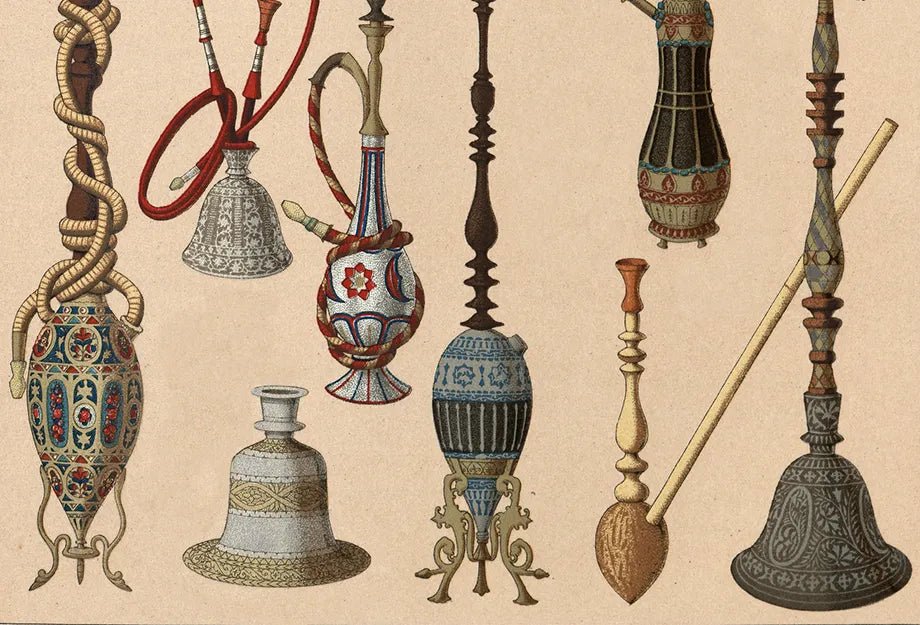
The Cultural Significance of Shisha in Middle Eastern Countries
Share
Shisha, also known as hookah, has a rich cultural history and holds significant importance in many Middle Eastern countries. It is more than just a method of smoking; it is a social tradition that fosters community, hospitality, and relaxation. In this comprehensive blog post, we will delve into the cultural significance of shisha in the Middle East, exploring its historical roots, social aspects, and enduring popularity.
Table of Contents
- Introduction
- Historical Roots of Shisha
- The Social Role of Shisha
- Shisha in Modern Middle Eastern Society
- Shisha Cafés and Lounges
- Traditional Shisha Ceremonies
- The Art of Shisha Preparation
- Shisha as a Symbol of Hospitality
- Health Considerations and Cultural Practices
- The Global Spread of Shisha Culture
- Conclusion

1. Introduction
Shisha smoking is a deeply ingrained cultural practice in many Middle Eastern countries. It is an activity that brings people together, providing a shared experience that transcends social boundaries. This article aims to explore the various facets of shisha culture, highlighting its significance and impact on Middle Eastern society.
2. Historical Roots of Shisha
The history of shisha dates back several centuries, with its origins believed to be in India or Persia. It was later brought to the Middle East, where it became an integral part of the cultural fabric.
Keywords: history of shisha, origins of shisha, shisha in Persia, shisha in India, shisha historical roots.
The Origins:
- Persia and India: Shisha is thought to have originated in the Persian Empire or India during the 16th century. The early designs were simple, using coconut shells as bases.
- Evolution: As shisha spread to the Ottoman Empire and other Middle Eastern regions, its design and construction evolved, incorporating intricate glass bases and artistic metalwork.
Cultural Integration:
- Ottoman Empire: Shisha became popular in the Ottoman Empire, where it was embraced by the elite and common people alike. It was during this period that shisha gained cultural and social significance.
- Middle Eastern Spread: From the Ottoman Empire, shisha spread to other parts of the Middle East, including Egypt, Lebanon, Syria, and Saudi Arabia, becoming a staple of social gatherings.

3. The Social Role of Shisha
Shisha plays a pivotal role in social interactions in the Middle East. It is often associated with hospitality, relaxation, and community.
Keywords: shisha social role, shisha hospitality, shisha and community, shisha social interactions.
Social Gathering:
- Community Building: Shisha smoking is a communal activity that encourages social interaction and bonding. It is common to see groups of friends and family members gathered around a shisha, engaging in conversation.
- Relaxation: The act of smoking shisha is often associated with relaxation and leisure. The slow, rhythmic process of preparing and smoking shisha creates a calming atmosphere.
Hospitality:
- Welcoming Guests: In many Middle Eastern cultures, offering shisha to guests is a sign of hospitality and respect. It is a way to make guests feel welcome and valued.
- Social Etiquette: There are certain etiquettes associated with shisha smoking, such as sharing the hose respectfully and not blowing smoke in someone's face, which further reinforces social bonds.
4. Shisha in Modern Middle Eastern Society
Despite the changes brought about by modernization, shisha remains a significant cultural practice in the Middle East.
Keywords: modern shisha culture, shisha in contemporary Middle East, shisha and modernization.
Adaptation to Modern Life:
- Shisha Lounges: Modern shisha lounges and cafes have become popular urban social spaces. These venues blend traditional shisha smoking with contemporary amenities, attracting a younger, diverse crowd.
- Technological Integration: Innovations such as electronic shisha and portable hookahs have emerged, catering to modern preferences while retaining traditional elements.
Youth Culture:
- Youth Engagement: Shisha smoking has seen a resurgence among young adults, who view it as a fashionable and social activity. This renewed interest has helped preserve the tradition in the face of changing social dynamics.

5. Shisha Cafés and Lounges
Shisha cafés and lounges are central to the social life in many Middle Eastern cities. These establishments serve as communal spaces where people gather to relax, socialize, and enjoy shisha.
Keywords: shisha cafes, shisha lounges, Middle Eastern shisha venues.
Traditional and Modern Venues:
- Traditional Cafés: These establishments often feature traditional decor, music, and a wide selection of shisha flavors. They provide a nostalgic experience reminiscent of historical shisha practices.
- Modern Lounges: Contemporary shisha lounges incorporate modern design elements and amenities, offering a chic and comfortable environment. They often serve gourmet food and beverages, enhancing the overall experience.
Social Hubs:
- Meeting Places: Shisha cafés and lounges are popular meeting places for people of all ages. They offer a relaxed setting for friends to catch up, for business meetings, and for social networking.
- Cultural Events: Some shisha venues host cultural events, such as live music, poetry readings, and art exhibitions, further enriching the cultural experience.

6. Traditional Shisha Ceremonies
In some Middle Eastern countries, shisha smoking is part of traditional ceremonies and celebrations.
Keywords: traditional shisha ceremonies, shisha rituals, shisha celebrations.
Cultural Significance:
- Weddings: Shisha is often featured in wedding celebrations, symbolizing joy and togetherness. It is a common sight at wedding receptions, where guests gather around shisha tables to celebrate.
- Festivals: During cultural festivals and religious celebrations, shisha is enjoyed as a part of the festivities, bringing people together to share in the communal experience.
Rituals:
- Preparation Rituals: The preparation of shisha itself is a ritualistic process, involving specific techniques and tools. This ritual is passed down through generations, preserving the cultural heritage.
7. The Art of Shisha Preparation
The preparation of shisha is considered an art form, requiring skill and knowledge to achieve the perfect smoking experience.
Keywords: shisha preparation, art of shisha, shisha preparation techniques.
Key Elements:
- Tobacco Selection: Choosing the right tobacco is crucial. Traditional flavors like apple, mint, and grape remain popular, while modern blends offer a variety of exotic tastes.
- Heat Management: Properly managing the heat from the coals is essential to ensure smooth and flavorful smoke. This involves carefully arranging and rotating the coals to maintain consistent heat.
- Packing the Bowl: The technique of packing the shisha bowl affects the quality of the smoke. It should be packed evenly and not too tightly to allow for proper airflow.
Cultural Techniques:
- Family Traditions: Many families have their own unique methods and recipes for preparing shisha, passed down through generations.
- Community Sharing: Knowledge of shisha preparation is often shared within communities, enhancing the collective expertise and appreciation for the practice.

8. Shisha as a Symbol of Hospitality
Offering shisha to guests is a long-standing tradition in Middle Eastern hospitality, symbolizing warmth and generosity.
Keywords: shisha hospitality, shisha as a symbol, Middle Eastern hospitality traditions.
Welcoming Guests:
- Respect and Honor: Providing shisha to guests is a sign of respect and honor. It reflects the host's desire to make guests feel comfortable and valued.
- Shared Experience: Sharing shisha creates a bond between the host and guests, fostering a sense of community and connection.
Hospitality Practices:
- Ceremonial Offering: In some cultures, the offering of shisha is done with a certain ceremony, highlighting its importance as a gesture of goodwill.
- Inclusivity: Shisha sessions often include everyone present, promoting inclusivity and collective enjoyment.
9. Health Considerations and Cultural Practices
While shisha holds significant cultural value, it is important to be aware of the health considerations associated with its use.
Keywords: shisha health considerations, cultural health practices, shisha safety.
Health Risks:
- Toxic Substances: Shisha smoke contains harmful substances such as carbon monoxide, heavy metals, and carcinogens. Prolonged exposure can lead to respiratory and cardiovascular issues.
- Infectious Diseases: Sharing shisha hoses can increase the risk of spreading infections. Using disposable mouthpieces and maintaining hygiene can mitigate these risks.
Cultural Practices:
- Moderation: Many traditional practices emphasize moderation, encouraging responsible use of shisha to minimize health risks.
- Education: Raising awareness about the health risks associated with shisha is important to ensure informed and safe practices.

10. The Global Spread of Shisha Culture
Shisha culture has transcended its Middle Eastern origins, gaining popularity worldwide.
Keywords: global shisha culture, shisha international, shisha popularity worldwide.
International Adoption:
- Global Trend: Shisha bars and lounges have opened in cities across the globe, introducing shisha culture to new audiences.
- Cultural Fusion: In many places, shisha culture has blended with local traditions, creating unique hybrid experiences.
Cultural Exchange:
- Cultural Ambassadors: Middle Eastern immigrants and travelers have played a significant role in spreading shisha culture internationally.
- Global Influence: The global popularity of shisha has also influenced its practices in the Middle East, with new trends and innovations emerging from the cultural exchange.

11. Conclusion
The cultural significance of shisha in Middle Eastern countries is profound, reflecting centuries of tradition, social interaction, and hospitality. As shisha continues to evolve and spread globally, it remains a cherished cultural practice that brings people together. Understanding its history, social role, and modern adaptations helps to appreciate the rich tapestry of shisha culture. For more information and high-quality shisha products, visit locosshisha.com.

